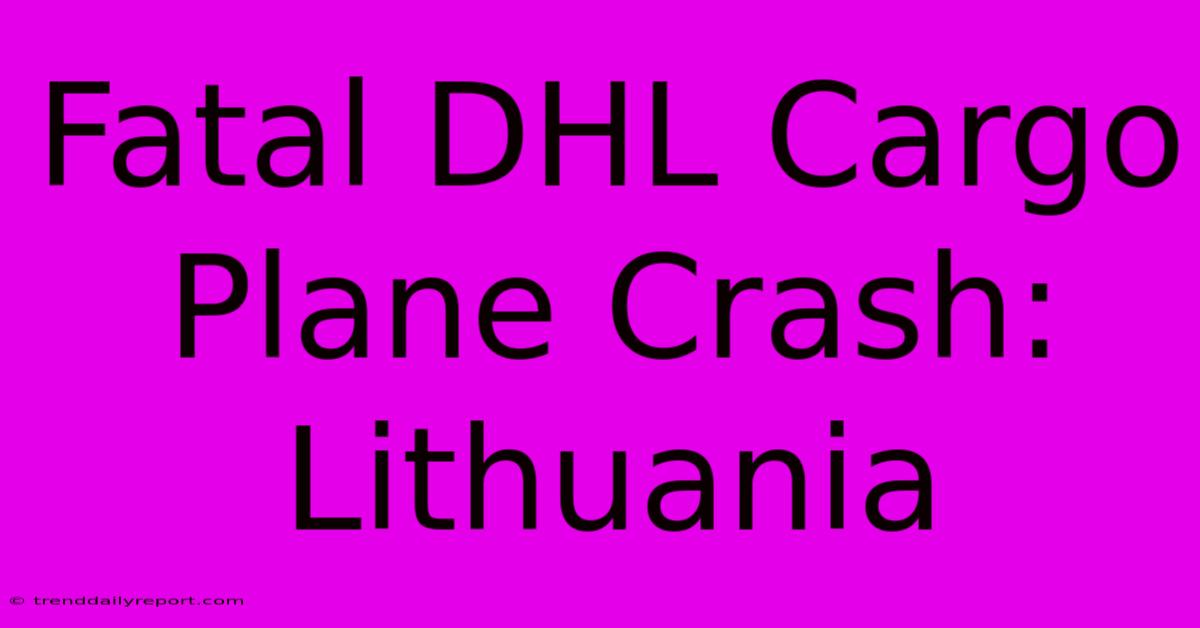Fatal DHL Cargo Plane Crash: Lithuania

Discover more detailed and exciting information on our website. Click the link below to start your adventure: Visit Best Website Fatal DHL Cargo Plane Crash: Lithuania. Don't miss out!
Table of Contents
Fatal DHL Cargo Plane Crash: Lithuania - A Tragic Accident and its Aftermath
So, I was just scrolling through the news the other day, and this story about the DHL cargo plane crash in Lithuania really hit me hard. It wasn't just another news item; it felt… personal, somehow. Maybe because I have a brother who's a pilot, always flying all over the place. Anyway, this accident in Vilnius, Lithuania, really got me thinking about air safety, the human cost of these incidents, and how much we rely on seemingly invisible systems to keep things running smoothly. You know? The stuff we just take for granted until something like this happens.
The Crash and its Immediate Aftermath
The crash itself was, from what I read, absolutely devastating. A Boeing 737-400, operated by DHL, crashed during its approach to Vilnius International Airport back in 2010. I remember seeing the photos – absolutely shocking. The impact must have been incredibly violent. Sadly, both the crew members lost their lives.
The initial investigation was, understandably, chaotic. Everyone was trying to figure out what went wrong, you know? Eyewitnesses, emergency responders, investigators, even folks on social media. It's crazy how much information flies around when something like this happens. It took quite some time to sift through it all and find the real story.
Investigating the Cause: A Deep Dive into Air Accidents
Getting to the bottom of what happened in air accidents is serious business, people. There are international bodies like the Aircraft Accident Investigation Board (AAIB) which does amazing work. These investigations are extremely thorough and go into incredible detail. They're not just about assigning blame. These guys are all about learning what went wrong to prevent future incidents.
That’s what I learned from this whole Lithuania DHL crash situation. The investigation found that a combination of factors likely contributed. I mean, there was no single cause, which is pretty common. One thing I read was that the weather conditions played a part; it seems visibility was pretty limited. Also, there were issues concerning the aircraft's maintenance and the pilots' approach.
They investigated everything! They checked the plane's black boxes — the flight recorders. They interviewed air traffic controllers, analyzed weather data, and went through maintenance records with a fine-toothed comb. Man, this stuff is meticulous.
Lessons Learned and Lasting Impacts
What really stuck with me wasn’t just the details of the crash itself, but the aftermath. The families of the pilots, of course, were devastated. Entire communities were affected. It's a sobering reminder that every flight, every package we receive, relies on the dedication and expertise of these professionals. And these incredible systems to keep things running.
Beyond the human element, this tragedy also highlighted the need for continuous improvements in air safety protocols and technologies. There were changes made within the industry, new regulations implemented, and further enhancements to training procedures for pilots. It's a painful reminder that safety is never a final destination; it's an ongoing journey.
Key Takeaways:
- Air safety is a complex issue: Multiple factors often contribute to accidents.
- Thorough investigations are crucial: They help us understand what happened and prevent future tragedies.
- Human lives are invaluable: The emotional cost of such accidents should never be underestimated.
- Continuous improvement is key: The aviation industry is always evolving to enhance safety standards.
This Lithuanian DHL crash story really drove home the importance of air safety. It's not just a matter of statistics; it's about real people, real lives, and the systems that support us all. Thinking about my brother up in the air, it makes me appreciate these unseen forces working to keep him (and everyone else) safe. Seriously, I never want to see a headline like that again.

Thank you for visiting our website wich cover about Fatal DHL Cargo Plane Crash: Lithuania. We hope the information provided has been useful to you. Feel free to contact us if you have any questions or need further assistance. See you next time and dont miss to bookmark.
Featured Posts
-
Barcelona Brest 3 0 Score Report
Nov 27, 2024
-
Acl Elite Mariners Vs Japan
Nov 27, 2024
-
First Champions League Real Madrids Win
Nov 27, 2024
-
Kanes Psg Transfer A Cautionary Note
Nov 27, 2024
-
Army Recruiting La And Atlanta
Nov 27, 2024
